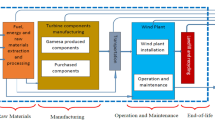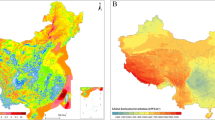Abstract
This study analyzes the wind speed characteristics, compares the six different methods (graphical, method of moment, wind energy pattern factor, empirical method of Justus and Lysen, and maximum likelihood method) of estimating Weibull parameters and calculates wind power density using daily mean wind speed data collected, at a height of 2 m, over a period of seven and eight years for Jumla and Okhaldhunga, respectively. Wind data were estimated at a height of 50 m to calculate average wind speed, Weibull parameters, and wind power density. Based on the results, Jumla has an average monthly maximum wind speed of 9.78 m/s in June and minimum wind speed of 6.71 m/s in December, whereas Okhaldhunga has an average monthly maximum wind speed of 10.95 m/s in April and minimum wind speed of 4.52 m/s in October. Jumla has an average annual wind speed of 8.11 m/s while Okhaldhunga has an average annual wind speed of 6.89 m/s. The accuracy of estimation methods was statistically tested using root mean square error and coefficient of determination. The empirical method of Justus and Lysen was found to be the best performing while the graphical method performed the poorest. By using the best method, an average wind power density has been estimated as 336.07 W/m\(^2\) and 326.73 W/m\(^2\) for Jumla and Okhaldhunga, respectively, indicating that both locations belong to wind power class III and have a moderate potential for wind energy harvesting.



Similar content being viewed by others
References
Ritchie, H., Roser, M.: Energy. Our World in Data. Https://ourworldindata.org/energy (2020)
IEA, Global Energy Review 2021. Tech. rep., Paris (2021). https://www.iea.org/reports/global-energy-review-2021 (2021)
International Renewable Energy Agency (IRENA), Renewable Energy Capacity Statistics 2021. Tech. rep., Abu Dhabi (2021)
Global Wind Energy Council (GWEC), Global Wind Report 2021. Tech. rep., Brussels (2021). https://gwec.net/global-wind-report-2021/
Parajuli, A.: A statistical analysis of wind speed and power density based on Weibull and Rayleigh models of Jumla, Nepal. Energy Power Eng. 8(7), 271 (2016)
Fyrippis, I., Axaopoulos, P.J., Panayiotou, G.: Wind energy potential assessment in Naxos Island, Greece. Appl. Energy 87(2), 577 (2010)
Bidaoui, H., El Abbassi, I., El Bouardi, A., Darcherif, A.: Wind speed data analysis using Weibull and Rayleigh distribution functions, case study: five cities northern Morocco. Proc. Manuf. 32, 786 (2019)
Hoxha, B., Selimaj, R., Osmanaj, S.: An experimental study of Weibull and Rayleigh distribution functions of wind speeds in Kosovo. L TELKOMNIKA (Telecommunication, Computing, Electronics and Control) 16(5), 2451 (2018)
Ucar, A., Balo, F.: An investigation of wind turbine characteristics and the wind potential assessment of Ankara, Turkey. Energy Sour., Part A: Recovery, Utilization, Environ. Eff. 33(13), 1291 (2011)
Arefi, F., Moshtagh, J., Moradi, M.: The wind energy potential of Kurdistan, Iran. Int. Sch. Res. Not. 2014, 9 (2014)
Soulouknga, M., Doka, S., Revanna, N., Djongyang, N., Kofane, T.: Analysis of wind speed data and wind energy potential in Faya-Largeau, Chad, using Weibull distribution. Renew. Energy 121, 1 (2018)
Ucar, A., Balo, F.: Investigation of wind energy potential in Kartalkaya-Bolu, Turkey. Int. J. Green Energy 6, 401 (2009). https://doi.org/10.1080/15435070903107098
Chang, T.P.: Performance comparison of six numerical methods in estimating Weibull parameters for wind energy application. Appl. Energy 88(1), 272 (2011)
Rocha, P.A.C., de Sousa, R.C., de Andrade, C.F., da Silva, M.E.V.: Comparison of seven numerical methods for determining Weibull parameters for wind energy generation in the northeast region of Brazil. Appl. Energy 89(1), 395 (2012)
Ahmed, S.A.: Comparative study of four methods for estimating Weibull parameters for Halabja, Iraq. Int. J. Phys. Sci. 8(5), 186 (2013)
Werapun, W., Tirawanichakul, Y., Waewsak, J.: Comparative study of five methods to estimate Weibull parameters for wind speed on Phangan Island, Thailand. Energy Proc. 79, 976 (2015)
Shaban, A.H., Resen, A.K., Bassil, N.: Weibull parameters evaluation by different methods for windmills farms. Energy Rep. 6, 188 (2020)
Ben, U.C., Akpan, A.E., Mbonu, C.C., Ufuafuonye, C.H.: Integrated technical analysis of wind speed data for wind energy potential assessment in parts of southern and central Nigeria. Clean. Eng. Technol. 2, 100049 (2021)
IRENA, Future of Wind: Renewable Power Generation Costs in 2020. Deployment, investment, technology, grid integration and socio-economic aspects. Tech. rep., Abu Dhabi (2019). https://www.irena.org/-/media/Files/IRENA/Agency/Publication/2019/Oct/IRENA_Future_of_wind_2019.pdf
IRENA, Renewable Power Generation Costs in 2020. Tech. rep., Abu Dhabi (2021). https://www.irena.org/-/media/Files/IRENA/Agency/Publication/2018/Jan/IRENA_2017_Power_Costs_2018.pdf
Nepal’s largest wind–solar hybrid power system switched on to connect a small village to the world. https://www.adb.org/news/nepals-largest-wind-solar-hybrid-power-system-switched-connect-small-village-world#:~:text=KATHMANDU (2017). Accessed May 3, 2021
Dhakal, R., Yadav, B.K., Koirala, N., Kumal, B.B., Moussa, H.: Feasibility study of distributed wind energy generation in Jumla Nepal. Int. J. Renew. Energy Res. 10(3), 1501 (2020)
Rahman, S.M., Chattopadhyay, H.: Statistical assessment of wind energy potential for power generation at Imphal, Manipur (India). Energy Sour., Part A: Recovery Utilization, Environ. Eff. (2019). https://doi.org/10.1080/15567036.2019.1675814
Prescott, R., Van Kooten, G.C.: Economic costs of managing of an electricity grid with increasing wind power penetration. Clim. Policy 9(2), 155 (2009)
Azad, A.K., Rasul, M.G., Yusaf, T.: Statistical diagnosis of the best Weibull methods for wind power assessment for agricultural applications. Energies 7(5), 3056 (2014)
Justus, C., Hargraves, W., Mikhail, A., Graber, D.: Methods for estimating wind speed frequency distributions. J. Appl. Meteorol. 17(3), 350 (1978)
Mohammadi, K., Alavi, O., Mostafaeipour, A., Goudarzi, N., Jalilvand, M.: Assessing different parameters estimation methods of Weibull distribution to compute wind power density. Energy Convers. Manag. 108, 322 (2016)
Akdağ, S.A., Dinler, A.: A new method to estimate Weibull parameters for wind energy applications. Energy Convers. Manag. 50(7), 1761 (2009)
Kaoga, D.K., Raidandi, D., Djongyang, N., Doka, S.Y.: Comparison of five numerical methods for estimating Weibull parameters for wind energy applications in the district of Kousseri, Cameroon. Asian J. Nat. Appl. Sci. 3(1), 73–88 (2014)
Hyndman, R.J., Koehler, A.B.: Another look at measures of forecast accuracy. Int. J. Forecast. 22(4), 679 (2006)
Zhang, M.H.: Wind resource assessment and micro-siting: science and engineering. Wiley, Hoboken (2015)
Ulazia, A., Sáenz, J., Ibarra-Berastegi, G., González-Rojí, S.J., Carreno-Madinabeitia, S.: Global estimations of wind energy potential considering seasonal air density changes. Energy 187, 115938 (2019)
Rehman, S., Ahmad, A.: Assessment of wind energy potential for coastal locations of the Kingdom of Saudi Arabia. Energy 29(8), 1105 (2004)
Teyabeen, A.A., Akkari, F.R., Jwaid, A.E.: Comparison of seven numerical methods for estimating Weibull parameters for wind energy applications. In: 2017 UKSim-AMSS 19th International Conference on Computer Modelling & Simulation (UKSim) (IEEE), pp. 173–178 (2017)
Boopathi, K., Kushwaha, R., Balaraman, K., Bastin, J., Kanagavel, P., Prasad, D.R.: Assessment of wind power potential in the coastal region of Tamil Nadu, India. Ocean Eng. 219, 108356 (2021)
Hayter, S.J., Kandt, A.: Renewable energy applications for existing buildings. Tech. rep., National Renewable Energy Lab.(NREL), Golden, CO (United States) (2011)
Author information
Authors and Affiliations
Corresponding author
Additional information
Publisher's Note
Springer Nature remains neutral with regard to jurisdictional claims in published maps and institutional affiliations.
Rights and permissions
About this article
Cite this article
Pandeya, B., Prajapati, B., Khanal, A. et al. Estimation of wind energy potential and comparison of six Weibull parameters estimation methods for two potential locations in Nepal. Int J Energy Environ Eng 13, 955–966 (2022). https://doi.org/10.1007/s40095-021-00444-7
Received:
Accepted:
Published:
Issue Date:
DOI: https://doi.org/10.1007/s40095-021-00444-7




